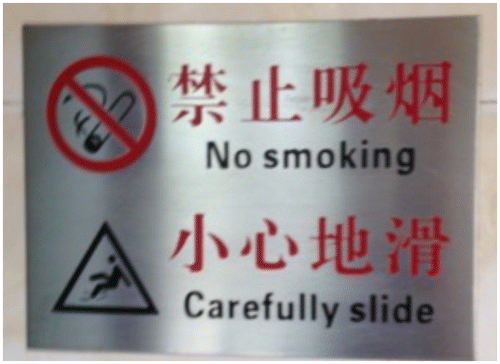In September 2016 I attended both the 34th CIHA World Congress of Art History in Beijing and a preconference workshop at the Chinese Academy of Art in Hangzhou.Footnote1 The two events were fascinating, not least from point of view of language and translation. Both were bilingual, with papers given in Mandarin Chinese and in English. Simultaneous translation was provided at Hangzhou, while at CIHA the papers had been pretranslated in both directions, and the translations were projected paragraph by paragraph on a secondary screen beside the screen showing the speaker’s images. Predictably, synchronicity between the speaker’s words and images and the translated text was not always achieved.
At both events, the essential bridge between the two languages was formed by the Junior Chairs: young and very brilliant Chinese scholars, who had studied or were still studying in the West, and who had a good command of English. They also translated the questions from the audience back and forward, from English to Chinese and vice versa.
One knows, however, that even in two very cognate languages—English and French or German and Dutch—there are endless possibilities for losing or changing the meaning of a sentence in the process of translating from one language to another. Between Chinese and English there are significant structural differences. Tense, for example, is usually indicated in Chinese by adding extra, explicatory words to the sentence. Similarly, one English word can expand into many Chinese characters when translated. Also, there are always ideas and concepts in the source culture that simply do not exist in the target culture. At Hangzhou, for example, I learned that there is no word in Chinese for “curator,” and the nearest the Chinese language gets is “exhibition organizer,” which entirely loses the sense of the creative and spatial articulation devised by the curator to add meaning to a series of objects in an exhibition. Similar problems exist, of course, in the other direction. The Chinese term Yi Jing (意境) is composed of two Chinese characters: Yi literally means “meaning” and “connotations,” and Jing means “place, space, border, area.” Combined as Yi Jing, the term is commonly used in the Chinese literary tradition to describe an artistic and literary idea that is entirely spiritual and often atmospheric; rather like the English word aura. Google Translation offers the rather bland “artistic conception,” which nowhere near conveys the richness and profundity of Yi Jing.Footnote2
To compensate for the losses that invariably go with translation, however, there are great gains. Jacques Derrida insisted that translation is always a “supplement” to the original, with the translator creating or at least rewriting the source text. The translation, therefore, is not simply a poor approximation, but an innovative intervention that inevitably brings something new. As the eminent translation theorist Lawrence Venuti insists:
Translating rewrites a source text in terms that are intelligible and interesting to receptor, situating it in different patterns of language use, in different literary traditions, in different cultural values, in different social institutions, and often in a different historical moment. […] When translated … the source text undergoes not only various degrees of formal and semantic loss, but also an exorbitant gain.Footnote3
Even mistranslation has a dynamism that is absent from the polished syntax of the native speaker. When a contributor to one of the Hangzhou sessions declared “it is honorable for me to take part in this workshop” he was stating an undisputable fact, but also alluding to the honor that he felt bestowed on him by the invitation to speak. Even at the most prosaic level, there are gains to be derived from such modest mistranslation. The sign in a public toilet at Yuanmingyuan Park in Beijing, for example, that warns “Carefully slide” (Figure ) is both an admonition and a challenge.
Such linguistic near misses open up new areas of understanding and cognition, which can be of positive benefit. Indeed, great gains are to be found in “creative misunderstanding,” a topic to which a whole session was devoted at the Beijing conference.Footnote4 This notion of a positive stimulus derived from misapprehension or misinterpretation has a potency that extends way beyond the confines of the conference hall, however, and it is interesting to speculate that the wonderful texts carefully and laboriously transported from one language to another in Art in Translation might serve not merely to transport detailed information across the linguistic divide, but also to stimulate “creative misunderstanding.”
Editor
Notes
1 For details on the program of the 2016 Comité International d’Histoire de l’Art (CIHA) conference in Beijing, see 〈http://www.ciha2016.org/〉 (accessed October 16, 2016).
2 I am most grateful to my former student, Dr Hsiu-ling Kuo, for her advice in framing this paragraph.
3 Lawrence Venuti, “Adaption, Translation Critique,” Journal of Visual Culture 6, no 1 (2007): 30.

